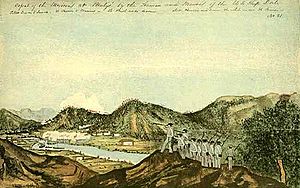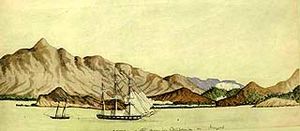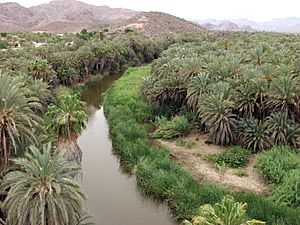Battle of Mulegé facts for kids
Quick facts for kids Battle of Mulegé |
|||||||
|---|---|---|---|---|---|---|---|
| Part of Mexican–American War | |||||||
 American forces after capturing the hill at Mulege. |
|||||||
|
|||||||
| Belligerents | |||||||
| Commanders and leaders | |||||||
| Strength | |||||||
| 17 marines 54 seaman Dale |
100 militia | ||||||
| Casualties and losses | |||||||
| 2 wounded | none | ||||||
The Battle of Mulegé was a fight during the Mexican–American War. It happened on October 2, 1847, in Mulegé, Baja California Sur. American Marines and sailors attacked Mexican fighters (called militia) in this town. The battle ended with a Mexican victory.
Contents
Why the Battle Happened
Setting the Scene for Conflict
In August 1847, Commodore William Shubrick took charge of the U.S. Navy's Pacific fleet. He ordered ships to block Mexican ports. One of these ships was the USS Dale.
The USS Dale Arrives
The USS Dale reached La Paz in mid-September. The U.S. commander there, Lieutenant Colonel Henry Stanton Burton, asked the Dale's commander, Thomas O. Selfridge, to sail to Loreto and Mulegé. The goal was to stop supplies from reaching Mexico and to ask local Mexicans to stay neutral.
On September 30, the Dale entered Mulegé's port. It first flew a British flag, then quickly changed it to the American flag. An American officer, Lieutenant Tunis Craven, went ashore. He told a Mexican officer that California was now American land. He also captured a Mexican ship called Magdalena.
Mexico Refuses to Surrender
On October 1, Commander Selfridge sent a letter to the Mexican leaders in Mulegé. He warned them to put down their weapons and stay neutral. Lieutenant Craven returned later to hear their answer. The Mexican commander, Captain Pineda, refused. He said he would not be neutral and protested the Dale's use of the British flag.
The Battle Begins
American Forces Land
Captain Pineda's refusal led to a fight. On October 2, 1847, at 2 PM, Lieutenant Craven led 17 Marines and 57 sailors ashore. They landed near Mulegé Creek. As they landed, the USS Dale began firing its cannons at the town. However, the cannon fire did not seem to do much damage.
Fighting on Land
The American Marines and sailors moved towards a hill. Mexican forces were on this hill, watching over the town. As the Americans advanced, shots were fired from a nearby house and a thick group of bushes.
Lieutenant Craven sent a small group to attack the house and burn it. He also checked the bushes. The house was burned, and no one was found hiding in the bushes or other houses.
The Americans then took the hill. The Mexican fighters retreated across a stream. From hidden spots, they fired at the Americans. The American forces fired back, forcing the Mexicans to run further up the creek.
Pushing Forward
The Americans marched into the village at the bottom of the hill. It was empty. They then moved to the River Road. Again, Mexican fighters attacked them from the thick jungle on the other side of the river. The Americans fired back, and a cannon from their boat also helped. This drove the Mexicans away. Lieutenant Craven's forces went about three miles from the river's mouth.
As night came, Lieutenant Craven decided to take his men back to the USS Dale.
Aftermath
Who Won?
Lieutenant Craven believed his forces had "punished" the Mexicans. However, Captain Manuel Pineda reported that "the enemy made off shamefully" after receiving "exemplary punishment." This shows that both sides felt they had done well.
What Happened Next
After the battle, the USS Dale sailed to La Paz. It arrived on October 8, bringing the captured Magdalena ship with it.
Commander Selfridge then rented a small ship called Libertad. He gave it a powerful cannon and put Lieutenant Craven in charge. Craven's new mission was to stop communication between Mulegé and Guaymas. On November 2, Craven captured another ship, the Alerta. He then headed towards Guaymas on November 19.
Images for kids






